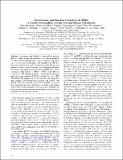| dc.contributor.author | Martin-Drumel, Marie-Aline | |
| dc.contributor.author | Lopez, Christopher A. | |
| dc.contributor.author | Crabtree, Kyle N. | |
| dc.contributor.author | Nguyen, Thanh L. | |
| dc.contributor.author | Thorwirth, Sven | |
| dc.contributor.author | Stanton, John F. | |
| dc.contributor.author | McCarthy, Michael C. | |
| dc.contributor.author | Nava, Matthew Jordan | |
| dc.contributor.author | Womack, Caroline C. | |
| dc.contributor.author | Cummins, Christopher C | |
| dc.date.accessioned | 2018-01-23T16:47:47Z | |
| dc.date.available | 2018-01-23T16:47:47Z | |
| dc.date.issued | 2016-09 | |
| dc.date.submitted | 2016-06 | |
| dc.identifier.issn | 0002-7863 | |
| dc.identifier.issn | 1520-5126 | |
| dc.identifier.uri | http://hdl.handle.net/1721.1/113278 | |
| dc.description.abstract | Thionitrous acid (HSNO), a potential key intermediate in biological signaling pathways, has been proposed to link NO and H₂S biochemistries, but its existence and stability in vivo remain controversial. We establish that HSNO is spontaneously formed in high concentration when NO and H₂S gases are mixed at room temperature in the presence of metallic surfaces. Our measurements reveal that HSNO is formed by the reaction H₂S + N₂O₃ → HSNO + HNO₂, where N₂O₃ is a product of NO disproportionation. These studies also suggest that further reaction of HSNO with H₂S may form HNO and HSSH. The length of the S-N bond has been derived to high precision and is found to be unusually long: 1.84 Å, the longest S-N bond reported to date for an R-SNO compound. The present structural and, particularly, reactivity investigations of this elusive molecule provide a firm foundation to better understand its potential physiological chemistry and propensity to undergo S-N bond cleavage in vivo. | en_US |
| dc.description.sponsorship | United States. National Aeronautics and Space Administration (Grant NNX13AE59G) | en_US |
| dc.publisher | American Chemical Society (ACS) | en_US |
| dc.relation.isversionof | http://dx.doi.org/10.1021/JACS.6B05886 | en_US |
| dc.rights | Article is made available in accordance with the publisher's policy and may be subject to US copyright law. Please refer to the publisher's site for terms of use. | en_US |
| dc.source | Other univ. web domain | en_US |
| dc.title | Spontaneous and Selective Formation of HSNO, a Crucial Intermediate Linking H₂S and Nitroso Chemistries | en_US |
| dc.type | Article | en_US |
| dc.identifier.citation | Nava, Matthew, et al. “Spontaneous and Selective Formation of HSNO, a Crucial Intermediate Linking H₂S and Nitroso Chemistries.” Journal of the American Chemical Society 138, 36 (August 2016): 11441–11444 © 2016 American Chemical Society | en_US |
| dc.contributor.department | Massachusetts Institute of Technology. Department of Chemistry | en_US |
| dc.contributor.mitauthor | Nava, Matthew Jordan | |
| dc.contributor.mitauthor | Womack, Caroline C. | |
| dc.contributor.mitauthor | Cummins, Christopher C | |
| dc.relation.journal | Journal of the American Chemical Society | en_US |
| dc.eprint.version | Author's final manuscript | en_US |
| dc.type.uri | http://purl.org/eprint/type/JournalArticle | en_US |
| eprint.status | http://purl.org/eprint/status/PeerReviewed | en_US |
| dc.date.updated | 2018-01-18T18:51:26Z | |
| dspace.orderedauthors | Nava, Matthew; Martin-Drumel, Marie-Aline; Lopez, Christopher A.; Crabtree, Kyle N.; Womack, Caroline C.; Nguyen, Thanh L.; Thorwirth, Sven; Cummins, Christopher C.; Stanton, John F.; McCarthy, Michael C. | en_US |
| dspace.embargo.terms | N | en_US |
| dc.identifier.orcid | https://orcid.org/0000-0002-9239-7505 | |
| dc.identifier.orcid | https://orcid.org/0000-0003-2568-3269 | |
| mit.license | PUBLISHER_POLICY | en_US |
